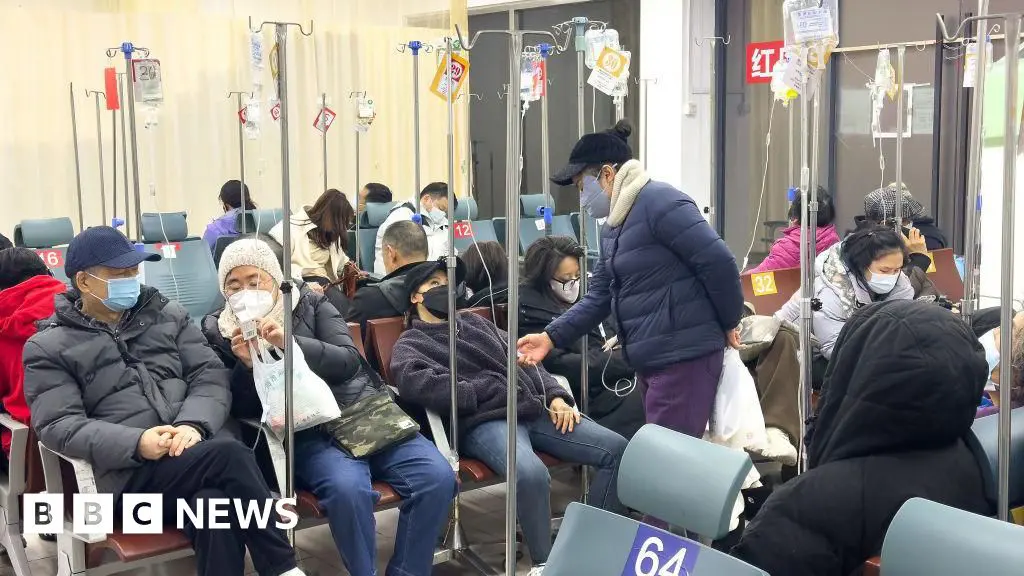HMPV: What to know about China's human metapneumovirus cases

In recent weeks, scenes of hospitals in China overrun with masked people have made their rounds on social media, sparking worries of another pandemic.
Beijing has since acknowledged a surge in cases of the flu-like human metapneumovirus (HMPV), especially among children, and it attributed this to a seasonal spike.
But HMPV is not like Covid-19, public health experts have said, noting that the virus has been around for decades, with almost every child being infected by their fifth birthday.
However, in some very young children and people with weakened immune systems, it can cause more serious illness. Here is what you need to know.
HMPV is a virus that will lead to a mild upper respiratory tract infection - practically indistinguishable from flu - for most people.
First identified in the Netherlands in 2001, the virus spreads through direct contact between people or when someone touches surfaces contaminated with it.
Symptoms for most people include cough, fever and nasal congestion.
The very young, including children under two, are most vulnerable to the virus, along with those with weakened immune systems, including the elderly and those with advanced cancer, says Hsu Li Yang, an infectious diseases physician in Singapore.
If infected, a "small but significant proportion" among the immunocompromised will develop more severe disease where the lungs are affected, with wheezing, breathlessness and symptoms of croup.
"Many will require hospital care, with a smaller proportion at risk of dying from the infection," Dr Hsu said.
Like many respiratory infections, HMPV is most active during late winter and spring - some experts say this is because the viruses survive better in the cold and they pass more easily from one person to another as people stay indoors more often.
In northern China, the current HMPV spike coincides with low temperatures that are expected to last until March.
In fact many countries in the northern hemisphere, including but not limited to China, are experiencing an increased prevalence of HMPV, said Jacqueline Stephens, an epidemiologist at Flinders University in Australia.
"While this is concerning, the increased prevalence is likely the normal seasonal increase seen in winter," she said.
Data from health authorities in the US and UK shows that these countries, too, have been experiencing a spike in HMPV cases since October last year.
Fears of a Covid-19 style pandemic are overblown, the experts said, noting that pandemics are typically caused by novel pathogens, which is not the case for HMPV.
HMPV is globally present and has been around for decades. This means people across the world have "some degree of existing immunity due to previous exposure", Dr Hsu said.
"Almost every child will have at least one infection with HMPV by their fifth birthday and we can expect to go onto to have multiple reinfections throughout life," says Paul Hunter, a medical professor at University of East Anglia in England.
"So overall, I don't think there is currently any signs of a more serious global issue."
Still, Dr Hsu advises standard general precautions such as wearing a mask in crowded places, avoiding crowds where possible if one is at higher risk of more severe illness from respiratory virus infections, practising good hand hygiene, and getting the flu vaccine.
What is the HMPV virus in China? The human metapneumovirus and its symptoms, explained.

The human metapneumovirus, also known as HMPV, is reportedly surging in China, raising questions about what the illness is and if it's a concern to those in the U.S.
Chinese health officials have not confirmed that HMPV is what is driving hospitalizations in the country, and recent reports from China's Center for Disease Control and Prevention indicate the increase may actually be due to influenza A. But with less public knowledge around HMPV in the U.S., worries of a potential new pandemic have risen — though experts say there isn't need for alarm.
"The concern for a pandemic can be put at rest," Dr. Carla Garcia Carreno, Children's Medical Center Plano director of infection prevention and control, told CBS News, adding not only is the virus fairly stable, it's also not a novel virus like COVID-19 was. "This has been circulating for a while, so people have some immunity against this human metapneumovirus."
HMPV is a virus that can cause upper and lower respiratory disease in people of all ages. Young children, older adults and people with weakened immune systems are the most at risk for serious illness from the virus.
The length of illness varies depending on the severity on an individual's case but is similar to other respiratory infections caused by viruses, according to the Centers for Disease Control and Prevention.
According to the CDC, symptoms commonly associated with HMPV include:
"Clinical symptoms of HMPV infection may progress to bronchitis or pneumonia and are similar to other viruses that cause upper and lower respiratory infections," the CDC's website notes.
HMPV is not new. It was first discovered in 2001 and is part of the Pneumoviridae family along with respiratory syncytial virus, or RSV, according to the CDC.
It may have been circulating even earlier — for decades or over a century, Garcia Carreno said.
In the U.S., HMPV typically circulates beginning in the winter and lasts until or through spring, the CDC says, and can circulate simultaneously with RSV and the flu during the respiratory virus season.
Experts say the HMPV outbreak in China is not of major concern — it is neither a new, mystery illness nor responsible for as many cases as COVID or other infections even this season. According to the latest CDC data, HMPV accounts for less than 2% of weekly positive tests of respiratory viruses. In comparison, the flu accounted for nearly 19% and COVID just over 7% for the same week.
For a disease to be considered widespread locally, it needs to be above 10% of positive results for two weeks. At 1.9%, Garcia Carreno said it's not close to the numbers of flu, COVID and RSV.
Researchers estimate that about 10% to 12% of respiratory illnesses in children are caused by HMPV, according to the Cleveland Clinic.
"Most cases are mild, but about 5% to 16% of children will develop a lower respiratory tract infection like pneumonia," the clinic's website adds.
HMPV is transmitted through direct contact with someone who has it or from touching things contaminated with the virus.
"Unfortunately, compared to flu, RSV and COVID, we don't have a vaccine for human metapneumovirus, so we don't have that advantage of priming over or boosting our immune system to fight these viruses," said Garcia Carreno. "But still, everything else that we learned for COVID can apply to methane."
To prevent illness, take similar steps to preventing other respiratory viruses, meaning wash hands with soap and water and avoid close contact with sick people.
"If somebody's sick, try to avoid crowding so they don't expose everybody, especially the vulnerable people," said Garcia Carreno. "If that person is sick and can not avoid going to a place where other people are, then try to use a mask, use cough and sneezing etiquette and good hand washing."
